The Great American Interchange
The Great American Interchange
Did you ever wonder why North America has only one marsupial – the Virginia Opossum? Or maybe you’ve wondered why we have any marsupials at all? Aren’t marsupials an Australian thing? It wasn’t anything I’d ever thought about until one day I was watching one of my favorite YouTube channels, “Lost in the Pond” (which has nothing at all to do with bodies of water or the life that lives in and around them.)

Laurence, the host of the podcast, was talking about things he’d never heard of before moving from the United Kingdom to the United States, and one of those things was the opossum. He mentioned that the opossum came north as part of the Great American Interchange (and he wasn’t talking about an interstate highway interchange). Intrigued, I had to find out what this was all about, so I started with a little research about marsupials. Today, out of the roughly 300 species* of marsupials, about two-thirds of them live in Australia. Most of the rest live in South America. In fact, by the time dinosaurs died out, South America was rife with marsupials, including predatory species such as saber-toothed marsupials and ferocious bear-like marsupials. At that time, South America was still attached to what is now Antarctica and had broken away from the rest of the supercontinent of Gondwana (which once included what is now South America, Africa, Arabia, Madagascar, India, Australia, and Antarctica).
Fun facts about the Virginia Opossum:
– It has more teeth (50 of them) than any other terrestrial North American mammal.
– A mother opossum can give birth to and raise three litters of up to 13 babies per year.
– It has many predators, so the life expectancy of an opossum in the wild is only 1 to 1.5 years.
What is a Marsupial?
Simply put, marsupials have a short-lived placenta that nourishes their young for just a few days before they’re born. The rest of their nutrition comes from the mother’s teats inside a pouch. Instead of the placenta, the mother’s milk nourishes the young and allows it to grow and develop.
When South America/Antarctica broke off from the rest of Gondwana, most of the marsupial species went with it. Australia was left with fewer marsupial groups. The species on the two continents continued to evolve, separately. Then, about 3 million years ago, the continents of North America and South America “bumped into” each other, creating a land bridge – the Isthmus of Panama. (It was a little more subtle than a bump. The two continents had been inching toward each other at a speed of about 2.5 centimeters per year.)
Land animals could now migrate from North to South America or vice versa. And a disproportionate number went from north to south. About half of all mammals in South America today are descended from North American mammals, while only about 10% of mammals in North America originated in South America.
North American predators such as foxes, cats and bears crossed to South America (pictured: jaguar)
Scientists currently believe that this disproportionate migration can be explained by a higher extinction rate among South American animals following the formation of the land bridge. South American predatory marsupials had disappeared, and their place in the ecosystems was taken up by North American predators such as foxes, cats and bears, which had more specialized carnivorous teeth and larger brains. Native South American mammals thus became more susceptible to predation The mammals that migrated from South America to North America were mostly armadillos, porcupines and opossums. Our only marsupial, the Virginia Opossum, is still here, and its range continues to expand.
For an informative animation of the Great American Biota Interchange, watch the 5-minute video What Happens When Continents Collide? From a Ted Talk by Juan D. Carrillo.
* Estimates of the number of marsupial species range from 270 to 330, depending on the source.
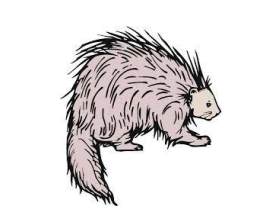
Porcupines originated in South America and migrated across the land bridge to North America.
Sources: Smithsonian Tropical Research Institute, CSIRO, Australia’s National Science Agency, Australia Museum, ZME Science.
What’s So Cool About the Axolotl?
What’s So Cool About the Axolotl?
I think I’ve mentioned before that I’m a volunteer docent at Connecticut’s Beardsley Zoo in Bridgeport, CT. As a docent, I get to talk to a lot of interesting people about all our fascinating animals!
Guests might come to the Zoo for any number of reasons – to see the Andean bear, or the Amur leopards, the prairie dogs, the bison, the red panda, the historic greenhouse or any of the baby animals (people love them all!). But what I heard one day surprised me.
“Excuse me,” a guest said, “but can you tell me where to find the Axolotl? It’s the only reason we came to the Zoo today!”
Don’t get me wrong. It’s not that I don’t think the Axolotl isn’t a fascinating creature; it most certainly is! But it’s not the most cuddly animal we have, many people have never heard of it, and it’s a salamander – not the most well-loved of animals. So I decided to dive into information about the Axolotl. It didn’t take long for me to realize why people might be enthralled by it: it’s incredibly cute and has inspired characters in Pokemon and Animal Crossing, made an appearance in Minecraft and has even been featured as a Google Doodle.
So I wanted to share with you all the highlights of what I learned.
What’s so cool about the Axolotl? Legend has it that the Axolotl is the Aztec god of fire and lightning, Xolotl, who disguised himself as a salamander to avoid being sacrificed. But that’s not all that makes them a little bit god-like. They have an impressive ability to regenerate lost limbs and stay “young” throughout their lives.
With a happy little face and frilly gills, it’s like the amphibian version of a puppy. This cuteness is caused by literally not growing up properly. Their youthful traits include feathery gills sprouting from their heads like a mane, webbed feet, a dorsal fin that runs down the length of their body, and a tail. Though they keep their gills, adult Axolotls also have functional lungs and can breathe through their skin. And as if being forever-youthful didn’t make them cute enough, their mouths are upturned in a permanent Mona Lisa smile.
Most salamanders undergo metamorphosis from their totally aquatic larval form to their mostly terrestrial adult forms. Not the Axolotl! It’s one of the salamander species that retains all of its larval features — external gills and a fin along its back —
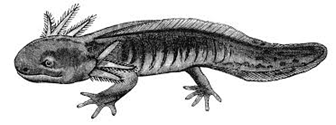
and remains completely aquatic, while being able to reproduce.
It can also regenerate almost any part of its body, including its limbs, eyes and even parts of its brain, which makes it of great interest to scientists studying regenerative biology.
Why is it endangered? It’s only found in Lake Xochimilco and Lake Chalco, near Mexico City. Unfortunately, Lake Chalco was drained by humans to avoid flooding (the ultimate loss of habitat), and Lake Xochimilco is severely diminished, having been reduced to mostly canals. Add to that pollution, and the introduction of invasive predators that eat baby salamanders, and the result is a species that is Critically Endangered with just 50 to 1,000 remaining in the wild.
What Color Are They? You may see pictures of axolotls that are either brownish gray or white and pink. Wild axolotls are dark, while captive animals are often white with pink gills.
Lifespan: Despite being able to regenerate, they do not live forever. Their lifespan is between 10 and 15 years.
The Axolotl is so beloved it is the national amphibian of Mexico and appeared on a 50 peso bill released in 2021.
For information about what Mexico is doing to help save the Axolotl, visit npr.org. Here you’ll also find a link to information about how to can adopt an Axolotol.
Everybody Does It
Everybody Does It
I adapted this blog from an article I wrote for a newsletter that I edit:
Whenever we’re talking about kids being kids, one of my brother’s favorite stories to tell is this: The first time he took his youngest to a zoo, one of the first animals they encountered was an elephant. As they stood there admiring the beast, they noticed a pair of elderly ladies nearby. Just then, the elephant decided it was a good time to defecate. PLOP!!! A large, steaming pile landed on the ground. The elderly ladies were appalled by the sight! My nephew, on the other hand, was enthralled! He and my brother continued on their way, seeing many other fascinating creatures –
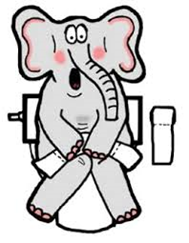
a giraffe, a cheetah, some monkeys and more. As they were driving home, my brother said, “So, Drew, what was your favorite thing at the zoo today?” Drew replied without hesitation, “When the elephant made that big poop!” It was apparently the coolest thing ever!
The Scoop About Poop
Poop is important, and not just for the amusement of little boys. It can tell us a lot. It also plays a significant role in the life of plants (and they don’t even poop!)
Poop and Conservation
If you’re out in nature, poop can let you know that certain animals are around. That can be helpful. After all, it might be good to know if there’s a black bear around, and if you see fresh bear scat there’s a good chance there’s a bear in the vicinity. (There are plenty of apps and guides to help identify whose scat you’re seeing.) But there’s a much bigger picture to consider.
Wildlife biologists analyze scat for several purposes. They can look for clues about an animal’s diet, habits and movement. They can determine the animal’s movements and even if and how it is related to other animals in the area. They can determine its diet and whether it has any diseases or parasites. As you can read at themeateater.com, “in terms of biology, poop paints a picture, and biologists can read that crap as if it were a book about the animal’s life.” Poop is important!
This is where dogs come in. Studying scat is becoming so important for conservation of species that Working Dogs for Conservation (WD4C) and other groups are training dogs to sniff out scat of endangered species, invasive species, animals that might be carrying diseases in wild populations and more. By analyzing scat, biologists can learn about animals without having to capture, test and release them – which is expensive, difficult to do, very stressful for the animal and dangerous for both the animals and the people involved.

Poop and Seed Dispersal
We all know that plants form fruits with seeds and that the seeds germinate and grow into the next generation of plants. But have you ever noticed a plant or a tree growing nowhere near any others of its kind? Did you ever wonder how it got there? Some seeds are dispersed by wind or water, but many types of seeds are dispersed by… you guessed it! Animal poop!
Here’s how it works: a fruit-eating animal eats the fruit containing the seeds. The seeds pass all the way through the animal’s digestive tract and are deposited in the animal’s poop, sometimes far away from the parent plant. Sometimes, the animal that ate the fruit gets eaten by something else – a coyote, for example – and the seed will be deposited in the predator poop even farther away from the parent plant.
Take this fun Poop Quiz!
Fun Facts! Six animals are notable for having weird poop.
Match the animal in the left column with the poop fact in the right column.
|
1. Parrotfish |
a. They poop cubes |
|
2. Sloth |
b. They clean with their poop |
|
3. Wombat |
c. They poop sand |
|
4. Giant Panda |
d. They only poop once a week |
|
5. Capybara |
e. They poop up to 50 pounds a day |
|
6. Turkey Vultures |
f. They have 2 kinds of poop |
For the answers, and for more information, see Poop Quiz Answers below.

An additional bonus for the seed? The poop surrounding it acts as a natural fertilizer, providing the new plant with the nutrients it needs to grow.
Poop Quiz Answers
1. Parrotfish: c. They poop sand

The parrotfish’s diet is high in coral. As they digest, the body breaks down the coral into sand. Those gorgeous white sandy beaches in Hawaii? Almost all parrotfish poop!
- Sloth: d. They only poop once a week.
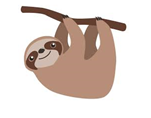
They poop only on the ground, where they are very vulnerable. To lessen the risk, it is believed that they only poop once a week. When they do, they lose up to 50% of their body weight!
3. Wombat: a. They poop cubes.

Wombats have very slow digestion and their intestines have ridges. Their diet is also very high in fiber; their poop comes out in almost perfect cubes – 80 to 100 pellets daily!
4. Giant Panda: e. They poop up to 50 pounds a day.

They poop up to 50 pounds a day. They only eat bamboo (which contains hardly any protein and lots of indigestible fiber). They need to eat between 26 and 84 pounds of food each day. That produces a lot of poop – about 50 pounds a day! (It’s why they usually have dedicated ACSs – in addition to regular care, they’re moving up to 50 pounds of poop every day!)
5. Capybara: f. They have two kinds of poop
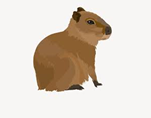
The first kind of Capybara poop is what you usually think of as poop – black or brown with no nutritional value. The second kind is green. It’s soft, and full of nutrients. They or other capybaras can eat it later, when they need an energy boost. If they don’t need all of the nutrients they ingest, they just poop it out for sharing with others.
- Turkey Vultures: b. They clean with their poop.

Turkey vulture poop is filled with good bacteria that can kill bad bacteria. So, if they’ve been scavenging all day and standing in carrion – rotting corpses – a good poop on their feet will help keep them from getting sick from the bad bacteria. They might also poop on their feet just to cool off!
– From mainlineplumber.com
That’s a lot of information about poop! And we didn’t really even get to bird poop. Maybe that’s for another blog…
Breathe Easy

“Breathe Easy: Heartwarming Conservation Victories Amidst Climate Concerns”
I don’t know about you, but I’m exhausted by news of several catastrophic climate events so far this year: heat waves and heat domes, uncontrolled wildfires that blocked the sun and affected air quality worldwide; cyclones in Asia, tornados here in the U.S., devasting floods, the hottest month on record (July 2023) ocean water temperature in excess of 100 degrees…. How about some good news for a change?
So, I googled “good conservation news” and here are just a few of the things I found out. There are a lot more; try googling it yourself!
Two California Condor chicks were born in the wild, in two separate nests (condors only lay one egg) in Pinnacles National Park in California. Both are healthy, currently testing very low for lead, and are expected to take flight on schedule in November. Condors are susceptible to lead poisoning due to eating meat contaminated by lead bullets. (Photo: NPS Pinnacles Instagram)
Palm Beach County in Florida has broken the record for most sea turtle nests in a season, with almost 22,000 as of August 1, with three months left in the season! Most of the nests belong to loggerhead turtles, but there are also many green sea turtles and leatherbacks as well. All three species are considered vulnerable or endangered.
The kipunji, a primate that lives in the Livingstone Mountains in Tanzania, was discovered and determined to be Critically Endangered at the same time – in 2003. Thanks to conservation efforts undertaken by the Wildlife Conservation Society (WCS) along with local community outreach, the kipunji numbers have increased by 65% in just 20 years. Illegal timber activity in the area is down 90%, helping to maintain habitat for these relatively newly discovered primates.
The Haiti magnolia was last seen in 1925 and was feared to be extinct following massive deforestation on its native island. Hoping the tree could have survived in higher elevations, a conservation team began a search for it and soon found 16 specimens in various stages of development growing in the Massif du Nord Mountain range. (Photo: Haiti National Trust)
Tiger populations are up to 40% higher than previously thought. The increase is not entirely due to an increase in numbers but to a change in the way they’re monitored. It seems we may have been undercounting them. They remain endangered, but areas where they are protected have been expanding, so there’s hope for continued improvement. (Photo: Reka by Jack Bradley)
Finally, one item that’s close to my heart: Piping Plovers at Milford Point in Connecticut had a record year, thanks in part to persistent birds, but also thanks to a group of dedicated coastal rangers who walk the beach during nesting season, protecting birds and educating visitors. Sixteen pairs of the federally-threatened species nested there in 2023 and fledged about 30 young birds! That is over 1.5 birds fledged per nest – enough to increase the population across the range. I know that doesn’t sound like a lot of birds, but it’s just a small sampling of the Piping Plover population in Connecticut, and it show what we can achieve with concerted conservation efforts!
Go ahead and google “good conservation news” and see what you find out!
“Ellie’s Day at the Zoo”: A Captivating Children’s Book Set to Shine at the Frankfurt International Book Fair”
“Ellie’s Day at the Zoo” takes young readers on a remarkable journey as they join Ellie, a spirited and curious girl, on an unforgettable adventure through the enchanting world of animals. With its engaging storyline and vibrant illustrations, the book aims to ignite imaginations, foster a love for reading, and impart valuable life lessons.
The Frankfurt International Book Fair stands as the pinnacle event in the global publishing industry, attracting authors, publishers, and literary enthusiasts from around the world. As a featured participant at this prestigious fair, Carol Story is excited to connect with fellow professionals, engage with a diverse audience, and explore potential collaborations with international publishers and agents.
In anticipation of the fair, Carol Story shared her enthusiasm, stating, “I am beyond thrilled to present ‘Ellie’s Day at the Zoo’ at the Frankfurt International Book Fair. This book is a labor of love, and I am excited to share Ellie’s magical journey with young readers and their families. It is my hope that this story sparks their imagination, encourages a sense of wonder, and imparts important life lessons in a fun and engaging way.”
Readers, literary enthusiasts, and industry professionals attending the Frankfurt International Book Fair are encouraged to visit Carol Story’s book placed in the bookshelves, to experience the magic of “Ellie’s Day at the Zoo” firsthand. Get ready to embark on a captivating adventure that will leave you inspired and captivated.
For further information, please contact Carol Story at carols5835@gmail.com
Media Contact
Company Name: Authors Innovation
Contact Person: Carol Story
Email: Send Email
City: Frankfurt
Country: Germany
Website: authorsinnovation.com

So, I’ve been challenged to write a blog, but where to start? Since this is posting on my new author’s website, maybe I should start with that. How did this whole thing – me writing books get started? I think I should start with a story, and if you’ve read Ellie’s Day at the Shore, you already know it!
When I was a young girl, my mother used to tell me the story of one summer when she was small, in the 1930’s. She was outside on the beach in Charlestown, Rhode Island. It was late summer and she saw a moving cloud coming toward her, blocking out the sun! It turned out to be a huge group of migrating Monarch butterflies! She was amazed and enthralled, and she remembered that experience all of her life – and she lived to be 94!
Monarch butterflies are amazing insects! In the eastern United States they really do (or did, when there were a lot more of them) fly in big flock from as far north as Canada to spend the winter in Mexico. When winter is over, they start their journey back up north. The most surprising thing is that no single butterfly makes the entire trip. It takes four generations – great grandmother, grandmother, mother, daughter! – to make it. So, if the daughter was never in Mexico to start with, how does she know where to fly back to? Like I said earlier, amazing!
As with many other animals and plants, there aren’t as many Monarchs now as there used to be. They’ve recently been put on the Endangered Species list. This sounds like a bad thing, but in reality, their numbers have been going down for many years. It could actually be a good thing, going on that list. It will help raise awareness to their plight. People all across America are trying to help, and we can all help by planting the kind of bushes Monarchs like in our garden, if we have one. You could even set up and register a Monarch Waystation. (Visit https://www.monarchwatch.org/waystations/ for lots more information about Monarchs, including how to set up a waystation.)
But I digress. When COVID hit in 2020, I checked in with friends to make sure they were doing okay. One of them, Maryanne Brown, knew that I (like my mom) wrote rhymes and suggested I write a children’s book based on the work I had done monitoring shorebirds for the Audubon Alliance for Coastal Waterbirds on the Connecticut shoreline. It was so fun and rewarding monitoring those birds! I watched as Piping Plovers and American Oystercatchers arrived on the beaches and the males staked out their territories and mated with the females. Then eggs were laid and both parents helped incubate the eggs until finally the eggs were hatched and tiny little fluffballs started running around the beach!
The parents were very good at protecting the chicks, which blend right in with the beach and are almost impossible to see unless you catch their movements. In fact, they hide in plain sight by freezing in position until the danger passes. Did you know that if you or any other dangerous creature gets too close to the chicks the parent will pretend to be injured and attempt to lead you away from the babies? It happened to me one day. I was walking along the beach and suddenly an adult Piping Plover nearby got very excited, acting like it had a broken wing. I already knew what this meant – babies around! – so I stopped walking and looked and looked for the babies but I couldn’t find them. The parent was getting more and more agitated, so I started backing away very slowly (I didn’t want to step on any baby birds!), and all of a sudden, four little fluffballs started running the other way! They’d been right there near me but I couldn’t see them. It was so fun to see how well their camouflage worked!
Sorry, that was another digression! Anyway, as I thought about those birds, the other creatures I saw regularly at the shore during my walks, and the Monarch butterflies, I realized that they could all be tied together. The result is Ellie’s Day at the Shore.
Where will this blog take me next? I’m not sure. You’ll have to check back to find out!









